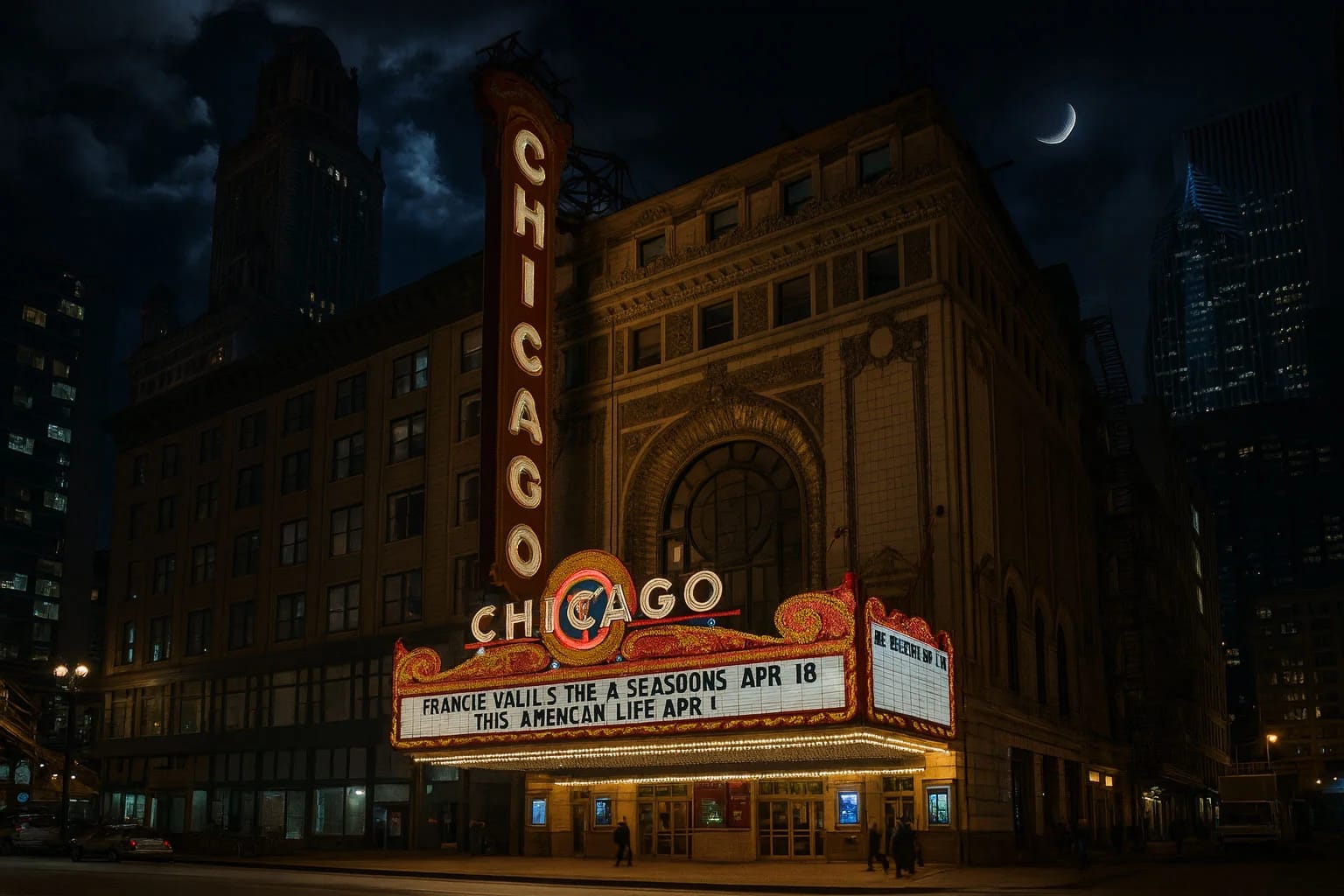The Chicago Theatre's brilliant marquee has been a symbol of the city since 1921, its gleaming lights reflecting off State Street in the heart of the Loop. The six-story sign announcing "CHICAGO" in vertical letters has become as iconic as any landmark in the Windy City.
Inside, the theatre's French Baroque architecture dazzles with its grand staircase, ornate chandeliers, and lavish decorations inspired by the Palace of Versailles. For over a century, this venue has brought joy, drama, and spectacle to millions of patrons.
But when the house lights dim and the audiences depart, another kind of performance begins. Staff members, security guards, and late-night workers report encounters with figures from another era - phantom ushers who still work their posts, ghostly performers who refuse to leave the stage, and unexplained phenomena that suggest the Chicago Theatre's greatest stars never truly took their final bow.
The History of the Chicago Theatre
The Chicago Theatre opened on October 26, 1921, as a motion picture palace designed by the renowned architectural firm of Rapp and Rapp. The lavish venue was built by theatre magnates Balaban & Katz, who spared no expense in creating what they called "The Wonder Theatre of the World."
A Palace of Entertainment
With 3,880 seats, the Chicago Theatre was one of the first large, lavish movie palaces in America. The interior design borrowed heavily from European palace architecture, particularly the Royal Chapel at Versailles and the Paris Opera House.
The grand lobby features a soaring five-story arcade with a grand staircase, ornate murals, crystal chandeliers, and marble columns. The auditorium itself is equally spectacular, with an ornate proscenium arch, elaborate plasterwork, and a massive Wurlitzer organ that rose from beneath the stage.
In its early decades, the theatre showed first-run films accompanied by live orchestral performances, vaudeville acts, and stage shows. The combination of cinema and live performance created an entertainment experience unlike anything Chicago had seen before.
The Golden Age
Throughout the 1920s, 30s, and 40s, the Chicago Theatre represented the pinnacle of entertainment in the city. Thousands packed the auditorium daily to see the latest Hollywood releases in unmatched luxury and grandeur.
The theatre also hosted numerous live performances, welcoming legendary entertainers to its stage. Everyone from Bob Hope to Frank Sinatra, from the Marx Brothers to modern rock stars has performed here.
But the golden age couldn't last forever. By the 1970s, the theatre had fallen into disrepair as downtown Chicago declined and suburban multiplexes drew audiences away. In 1985, the Chicago Theatre closed its doors, seemingly forever.
Restoration and Revival
Fortunately, preservationists recognized the theatre's architectural and cultural significance. After a complete restoration in 1986, the Chicago Theatre reopened as a venue for live performances, concerts, and special events.
Today, the theatre is once again a thriving cultural institution, hosting approximately 200 performances annually. The iconic marquee was designated an official Chicago Landmark in 2012, ensuring its preservation for future generations.
But while the building has been restored to its former glory, something else has persisted from those early decades - the ghosts of those who loved the theatre so much they never left.
The Ghosts of the Chicago Theatre
The paranormal activity at the Chicago Theatre is as varied and dramatic as the performances that grace its stage. Staff members and performers have reported numerous encounters with the theatre's permanent, if invisible, residents.
The Phantom Usher
The most frequently reported ghost at the Chicago Theatre is a male usher dressed in the formal uniform of the 1920s - complete with jacket, bow tie, and cap. He appears most often in the balcony sections, particularly in the upper levels of the auditorium.
Witnesses describe seeing him walking the aisles as if checking tickets or guiding patrons to their seats, just as he would have done nearly a century ago. When approached or called out to, he simply vanishes, sometimes mid-step.
Some staff members believe this is the spirit of an usher who worked at the theatre during its earliest years and loved his job so much that he continues his duties in death. Others have reported seeing not one but multiple phantom ushers, suggesting that several devoted employees remain at their posts.
Patrons settling into their seats before shows have reported feeling a tap on their shoulder, turning to find no one there. Security personnel checking the empty theatre late at night have seen the usher walking the aisles, his flashlight beam (though no actual light is visible) sweeping across the rows of seats.
The Woman in White
A female apparition in a long white gown has been seen throughout the theatre, but most frequently on the grand staircase in the lobby. She appears to be from the 1920s or 1930s, dressed elegantly as if attending a premiere or special event.
Witnesses describe her gliding up or down the stairs, sometimes pausing on the landing to look out over the lobby as if admiring the architecture or waiting for someone. Her appearance is so realistic that security guards have approached her, thinking she was a lost patron or trespasser, only to have her vanish before their eyes.
Some paranormal researchers speculate that she may be the ghost of a woman who died at the theatre, perhaps during its early years. Others believe she's a residual haunting - an imprint of a moment repeated endlessly, like a film loop playing in the ether.
The Woman in White is often accompanied by the scent of vintage perfume, a fragrance that staff members say smells distinctly old-fashioned, unlike anything worn today.
Phantom Music and Applause
When the theatre is empty and locked for the night, security personnel and cleaning crews have reported hearing sounds that shouldn't exist:
- The Wurlitzer organ playing from beneath the stage, though the instrument hasn't been operational in decades
- Orchestra music drifting through the auditorium, as if an invisible ensemble is rehearsing
- The sound of a full audience applauding, cheering, and laughing at a performance that isn't happening
- Footsteps on the stage, the distinctive sound of tap shoes, and even voices singing or reciting lines
These phantom sounds are most common late at night or in the early morning hours before the theatre opens. Multiple witnesses have described entering the empty auditorium to investigate the source of music or applause, only to have it stop the moment they step through the doors.
In some cases, security footage has captured these audio phenomena without any visual explanation - the cameras show an empty, dark theatre while the audio picks up the sounds of a performance in full swing.
The Figure in the Balcony
Performers on stage have reported seeing a solitary figure sitting in the upper balcony during rehearsals or sound checks - times when the theatre should be completely empty except for the technical crew.
This shadowy spectator appears to be watching intently, sometimes leaning forward as if not wanting to miss a moment of the performance. When stage crew members go to investigate or ask the person to leave, they find the balcony completely empty.
Some performers have reported that they feel this presence is benevolent, like a devoted theatre-goer who simply wants to enjoy the show. Several have said they've given better performances knowing this eternal patron was watching, finding comfort in the idea that someone appreciates their art enough to return from beyond the grave.
Unexplained Technical Malfunctions
The Chicago Theatre's technical crew has documented numerous instances of equipment behaving strangely:
- Stage lights turning on or off without anyone at the controls
- The grand curtain rising or falling on its own
- Sound equipment picking up voices, music, or applause when no one is performing
- Temperature fluctuations in specific areas of the theatre, particularly backstage and in the upper balconies
- Electromagnetic field anomalies detected by ghost hunting equipment
These phenomena occur most frequently during dark periods when the theatre is between shows, or during technical rehearsals late at night. While some can be attributed to old wiring or mechanical issues, many incidents defy conventional explanation.
One lighting technician reported programming a specific lighting cue for a show, only to have the system execute a completely different sequence - one that, when researched, turned out to be identical to the lighting used in a production from the 1940s.
Backstage Encounters
The backstage areas of the Chicago Theatre have their own ghostly residents. Performers and crew members have reported:
- Shadow figures moving through the wings and dressing rooms
- The sensation of being watched while changing costumes
- Dressing room doors opening and closing on their own
- Personal items moved or rearranged when the rooms were locked and empty
- Whispered conversations in the hallways when no one else is present
One recurring phenomenon involves mirrors in the old dressing rooms. Multiple witnesses have reported seeing figures reflected in the mirrors that aren't visible when they turn around - glimpses of performers from another era, still preparing for shows that ended decades ago.
Experiencing the Chicago Theatre
The Chicago Theatre continues to operate as one of Chicago's premier entertainment venues, hosting concerts, comedy shows, and special events throughout the year. The building is also available for tours, allowing visitors to experience the spectacular architecture and learn about the theatre's rich history.
Whether you're attending a performance or taking a tour, keep your eyes open. You might catch a glimpse of the phantom usher making his eternal rounds, or see the Woman in White gliding across the grand staircase. And if you hear applause echoing through an empty theatre, remember - in a building this beloved, devoted audiences never truly leave.
The Chicago Theatre stands at 175 North State Street in the heart of Chicago's Loop, its marquee still shining as brightly as the spirits that linger within.

The legendary marquee has watched over State Street for over a century

Where the Woman in White still walks the grand staircase

